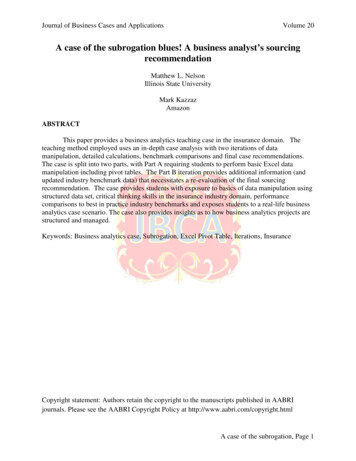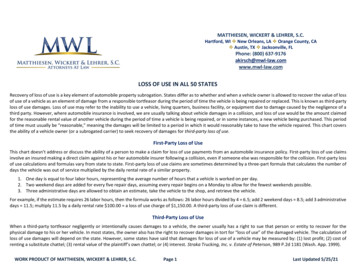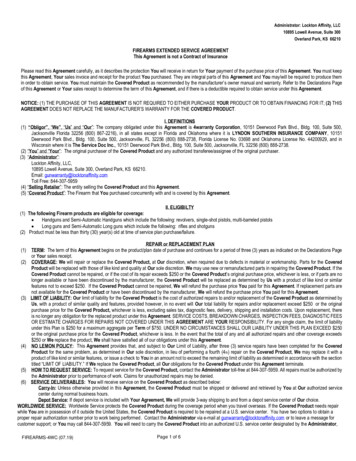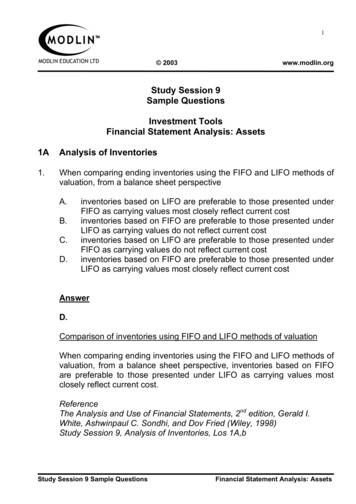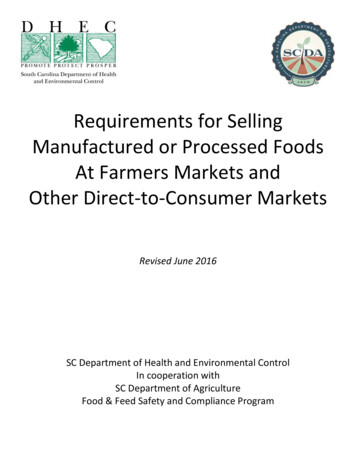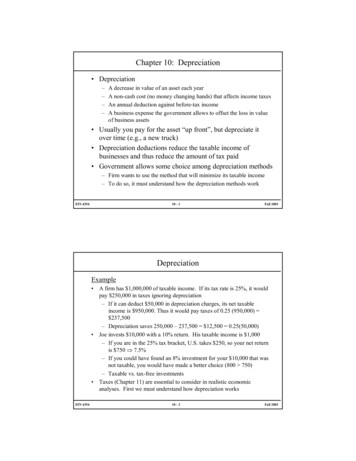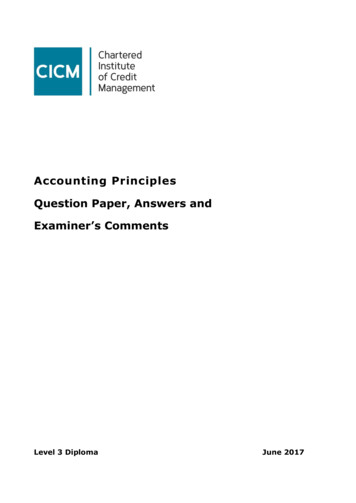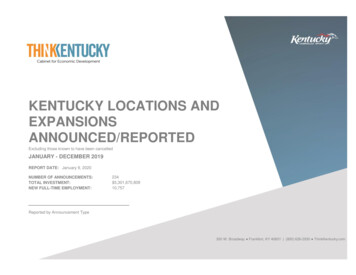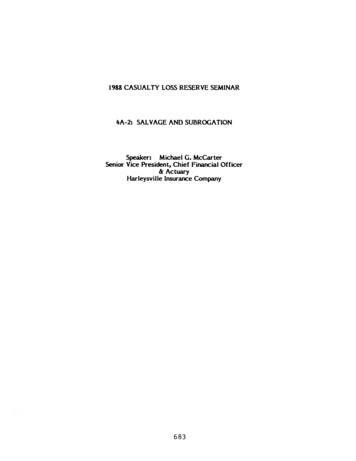
Transcription
1988 CASUALTY LOSS RESERVE SEMINAR4A-2: SALVAGE AND SUBROGATIONSpeaker: Michael G. McCarterSenior Vice President, Chief Financial Officer& ActuaryHarleysville Insurance Company683
(Slide I - O p e n i n q Title)MichaelMcCarter:Good afternoon.My name is Mike McCarter.I'm Chief F i n a n c i a lO f f i c e r and A c t u a r y of the H a r l e y s v i l l e I n s u r a n c e Companies.Thisis M i n i - S e s s i o n 4A-2, "Salvage and Subrogation".There are h a n d o u t sa v a i l a b l e at the e n t r a n c e to the room w h i c h include copies of myslide material.I've b e e n asked to let you know that the views Iexpress are my own and are not n e c e s s a r i l y those of the A m e r i c a nA c a d e m y of Actuaries, the C a s u a l t y A c t u a r i a l Society, or theH a r l e y s v i l l e I n s u r a n c e Companies.In addition, a l t h o u g h I will bet a l k i n g about taxes to some extent, you should consult w i t h y o u r taxa d v i s e r s on any tax questions.We will have time for q u e s t i o n safter my p r e s e n t a t i o n .Why are we all here today?This is the first time the C a s u a l t y Loss R e s e r v e S e m i n a r has o f f e r e da p r e s e n t a t i o n on S a l v a g e and Subrogation.Actually, other sessionshave p r o b a b l y m e n t i o n e d salvage and s u b r o g a t i o n as a p o t e n t i a ld i s t o r t e r of loss d e v e l o p m e n t patterns.Generally accepteda c c o u n t i n g p r i n c i p l e s have r e q u i r e d the b o o k i n g of salvage ands u b r o g a t i o n r e c o v e r a b l e for years.This has not changed.Statutorya c c o u n t i n g for salvage and s u b r o g a t i o n w h i c h g e n e r a l l y d i s a l l o w ssuch a r e c o v e r a b l e has not changed.One s i g n i f i c a n t factor has changed.As a result of the Tax R e f o r mAct of 1986, the Internal R e v e n u e Service has issued T e m p o r a r y andP r o p o s e d R e g u l a t i o n s for the 1988 tax year r e q u i r i n g r e c o g n i t i o n ofsalvage and s u b r o g a t i o n r e c o v e r a b l e in the d e t e r m i n a t i o n of t a x a b l eincome.On that p l e a s a n t note, we begin.(Slide 2 - O u t l i n eToday,Talk)I w a n t to do three things:I want to help you b e t t e r u n d e r s t a n d the h i s t o r i c a l factors thatframe the c u r r e n t d e b a t e b e t w e e n the IRS and the i n s u r a n c e industryon the s u b j e c t of salvage and s u b r o g a t i o n recoverable.I want to give you some feeling for the financial impact of thesalvage and s u b r o g a t i o n r e c o v e r a b l e estimate as well as for some ofthe key factors that you should bear in mind as you make yourestimates.Finally, I will r e v i e w a m e t h o d of e s t i m a t i n g salvage ands u b r o g a t i o n r e c o v e r a b l e and discuss some other m e t h o d s that you mayw i s h to consider.As you can tell from my outline, I'm going to be t a l k i n g about whatwe want to do, why w e ' r e doing it, and what p r o b l e m s we mayencounter.I'm not g o i n g to talk a great deal about the d e t a i l e dc a l c u l a t i o n s of the e s t i m a t i o n process.Once you have the f r a m e w o r k684
PageTwoset up, the detailed calculations are very similar to those of theother estimation problems being discussed at the Casualty LossReserve Seminar.First,about.here are some definitionsto clarify what we are talking(Slide 3 - Definitions)Salvage is the sale of damaged goods for which the insured has beenindemnified by the insurance company.The most typical example ofsalvage is when the insurance company sells the remains of a car towhich it has taken title after indemnifying the insured for thetotal pre-crash value of the car.Subrogation is the collection by the insurance company of theamount of a paid claim from a negligent third party or his insurer.Although subrogation is a liability concept, you may well find thatsubrogation actually outweighs salvage even in your company's autophysical damage experience.That's because to speed claimsettlement, your company has paid for the physical damage of yournot-at-fault insureds and then collected subrogation from theinsurance companies of the at-fault drivers.Salvage Recoverable is the estimated salvage and subrogation (net ofexpenses) to be recovered on all claims incurred to date, whetherreported or unreported.For the rest of my talk, when I speak ofsalvage or salvage recoverable, you should understand me to beincluding subrogation unless I specifically say otherwise.Also,I'd like to underline that our salvage recoverable estimate is netof the expenses incurred in collecting the salvage.So, how much money are we talking about here?(Slide 4 - InsuranceIndustryImpact)The 1988 Best's Aggregates and Averages reported almost 3 billionof salvage recovered in Schedule O lines which is over 8% of paidlosses for those lines.If we drop the A & H, Reinsurance, andWrite-in lines, salvage collected is over 11% of paid losses in theremaining Schedule 0 lines.86% of the salvage collected was in auto physical damage, bothpersonal and commercial.6% was in surety.Schedule P doesn'tcurrently break out salvage (it will soon), but it is generallyagreed that Workers' Compensation and Package Property are the lineswith significant salvage.One estimate is that subrogation aloneamounts to 2% of paid losses for those two lines.Based on the Schedule O data, one rough estimate is that theindustry's auto physical damage salvage recoverable should be about50% of its outstanding losses.If that's true, then the 1987 change685
Page T h r e ein auto p h y s i c a l d a m a g e loss reserves w o u l d have g e n e r a t e d e n o u g ha d d i t i o n a l s a l v a g e r e c o v e r a b l e to add 50 m i l l i o n to the industry'sfederal income tax bill at a 34% tax rate.In addition, the sixyear p h a s e - i n of the 12/31/87 initial salvage r e c o v e r a b l e b a l a n c ewill cost a n o t h e r i00 m i l l i o n per year.The total of 150 m i l l i o nper y e a r is 1/2 p o i n t of 1987 auto physical d a m a g e earned premium.We w o u l d p r o b a b l y need almost a point of rate increase to b r e a k evenon p r o f i t a b i l i t y after tax.This rate increase is just to cover thea d d i t i o n a l tax due to r e c o g n i z i n g salvage recoverable, not tor e c o g n i z e o t h e r impacts of the 1986 Tax R e f o r m Act.How did we get to w h e r e we are today?(Slide 5 - History)In the dawn of time, r e g u l a t o r s were c o n c e r n e d that i n s u r a n c ec o m p a n i e s w o u l d u n d e r s t a t e reserves by a n t i c i p a t i n g salvagerecoverables, so S c h e d u l e 0 was o r i g i n a l l y d e s i g n e d to allows e p a r a t e t r a c k i n g of salvage on claims closed as of the p r i o ryear-end.It's a little hard for me to imagine salvage r e c o v e r a b l eas the big r e s e r v e a d e q u a c y concern.However, that a c c o u n t i n gt r e a t m e n t e s t a b l i s h e d the separate t r e a t m e n t of salvage on c l o s e dclaims from o t h e r salvage. The IRS a t t e m p t e d to force c o m p a n i e s toc o n s i d e r s a l v a g e r e c o v e r a b l e in d e t e r m i n i n g t a x a b l e income, but theC o n t i n e n t a l and A l l s t a t e d e c i s i o n s in the 1970's c o n f i r m e d thatAnnual S t a t e m e n t a c c o u n t i n g c o n t r o l l e d tax accounting.SinceIllinois and M a r y l a n d and p o s s i b l y other states had r e g u l a t i o n sp r o h i b i t i n g r e c o g n i t i o n of salvage recoverables, the courts heldthat the IRS c o u l d not force such recognition.In 1976 and 1978 c h a n g e s were made to S c h e d u l e 0 that gave it thea c c i d e n t y e a r o r i e n t a t i o n it has today and then b r o u g h t the salvaget r e a t m e n t in line as well.The insurance industry was no longerr e q u i r e d to r e p o r t salvage on paid claims separately, and m a n yc o m p a n i e s s c r a p p e d their ability to do so, but the d i s t i n c t i o n didnot die for the IRS.The Tax R e f o r m Act of 1986S t a t e m e n t as a c o n t r o l l i n gwas d i r e c t e d to study andsalvage.At the b e g i n n i n gP r o p o s e d regulations.c o n s i d e r a b l y w e a k e n e d the Annualfactor for tax accounting.The T r e a s u r yissue r e g u l a t i o n s on the t r e a t m e n t ofof 1988 the T r e a s u r y issued T e m p o r a r y andThe 1966 I n d u s t r y A u d i t Guide for P & C C o m p a n i e s was silent onr e c o g n i t i o n of s a l v a g e r e c o v e r a b l e s under GAAP.The A I C P A ' sS t a t e m e n t of P o s i t i o n 78-6 issued in 1978 r e q u i r e d r e c o g n i t i o n ofsalvage recoverable.Since s t a t u t o r y and tax a c c o u n t i n g did notr e c o g n i z e s a l v a g e recoverable, the GAAP t r e a t m e n t a c c e l e r a t e d ther e c o g n i t i o n of income and thus c o n t r i b u t e d to a d e f e r r e d taxl i a b i l i t y on the G A A P b a l a n c e sheet.Those of you r e p o r t i n g on a GAAP basis must implement S t a t e m e n tFinancial A c c o u n t i n g S t a n d a r d s #96 by 1989 at the latest.686of
Page Four(Subsequent to the talk, the required implementation date was movedto 1990).This statement changed the calculation of deferred taxassets or liabilities and has become extremely controversial becauseof the interactions between it and the Tax Reform Act of 1986 asthat act impacts insurance company taxation.Booking salvagerecoverable for tax accounting will eliminate a timing differencethat in the past tended to generate deferred tax liabilities.Actually, the timing difference will not be completely eliminated ifthe tax salvage recoverable is discounted.I need to say a little more about salvage and the Tax Reform Act of1986.(Slide 6 - Tax Reform Act of 1986)The first thing to note is that the IRS methodology for calculatingdiscount factors for loss reserves uses payment patterns net ofsalvage for both Schedule O and Schedule P. Thus, to be consistent,the salvage recoverable estimate should be netted against the lossand loss expense reserve by line of business by accident year andthe net reserve discounted.Equivalently, the salvage recoverableshould be discounted for tax purposes using the existing discountfactors.The Temporary and Proposed Regulations concerning salvagethe beginning of 1988 are being disputed by the insuranceas exceeding the Treasury's authority under law.issued atindustryThe Treasury proposes that the change be treated as a change inaccounting.What that means in English is that we would not get aFresh Start benefit on the 12/31/87 balance.For most companiesthat balance would be brought into taxable income evenly over thenext 6 years.The associated GAAP deferred tax liability would comedown over the same period.Adding salvage recoverable to taxableincome would tend to reduce the book-tax differential preferenceitem and so slightly reduce the Alternative Minimum tax.This wouldbe a small consolation.The Temporary and Proposed Regulations discuss separately salvagerecoverable attributable to paid losses from that attributable tounpaid losses, and cite different authorities for the inclusion ofeach into taxable income.Some have concluded that this means thatour salvage recoverable estimate will need to be in two pieces withthe salvage recoverable attributable to paid losses presumably notsubject to discount.If that is the correct interpretation, we willhave some data problems that I will discuss shortly.Others, including a representative of the Treasury Department whospoke at last week's National Association of Independent Insurer'sFederal Income Tax seminar, feel that one salvage recoverableestimate will be required and that the Paid vs. Unpaid language isleft over from prior history.687
Page FiveThe T e m p o r a r y and P r o p o s e d R e g u l a t i o n s do not settle the q u e s t i o n ofe x a c t l y how the salvage r e c o v e r a b l e will be discounted.Fordiscussion, I will assume that the l o g i c a l l y c o n s i s t e n t m e t h o d ofd i s c o u n t i n g the entire salvage r e c o v e r a b l e u s i n g the e x i s t i n gd i s c o u n t factors will prevail.By the way, you are p r o b a b l y m a k i n ge s t i m a t e d 1988 tax p a y m e n t s using your GAAP salvage r e c o v e r a b l e asan estimate.Now, w h a t m u s t we c o n s i d e r as we set up the f r a m e w o r ke s t i m a t i o n of salvage r e c o v e r a b l e ?(Slide 7 - E s t i m a t i n gfor ourRecoverable)We will need to make e s t i m a t e s by line of b u s i n e s sin o r d e r to apply the IRS d i s c o u n t factors.and a c c i d e n t yearR e m e m b e r that w e ' r e e s t i m a t i n g an asset, not a liability. If youre s t i m a t e of s a l v a g e r e c o v e r a b l e is too high, your loss r e s e r v e s netof s a l v a g e r e c o v e r a b l e will d e v e l o p unfavorably.From a s o l v e n c yp o i n t of view, a high e s t i m a t e is not c o n s e r v a t i v e as it is for lossreserves.The r e s e r v e d e v e l o p m e n t s c h e d u l e s r e q u i r e d in the 10-Kfor SEC R e p o r t i n g are shown on a s t a t u t o r y basis by most companies.If the s a l v a g e r e c o v e r a b l e e s t i m a t e s by a c c i d e n t year are nowc a r e f u l l y done, it will be p o s s i b l e to do a true reserve d e v e l o p m e n ton a G A A P basis.Do you have the data you need?(Slide 8 - E s t i m a t i n gRecoverable- Data Considerations)If s a l v a g e r e c o v e r a b l e is netted against loss reserves for taxpurposes, then the f o l l o w i n g data c o n s i d e r a t i o n s will not bes i g n i f i c a n t for tax purposes.The most common p o t e n t i a l p r o b l e mwill be i n c o r r e c t or i n c o n s i s t e n t c l a s s i f i c a t i o n of salvage orsalvage e x p e n s e as a loss or loss expense.If all of these have thesame tax treatment, r e - c l a s s i f i c a t i o n will not matter.N e g a t i v e p a i d losses, such as Second Injury Fund r e c o v e r i e s orr e c o v e r i e s from other state funds, may be c l a s s i f i e d as salvage,c a u s i n g you to o v e r - e s t i m a t e salvage recoverables.S a l v a g e e x p e n s e s are e x p e n d i t u r e s in the course of o b t a i n i n g salvageor subrogation.Some of your salvage is o b t a i n e d on a c o m m i s s i o nbasls, so the s a l v a g e you record is a l r e a d y net of salvage expense.Your d i r e c t p a y m e n t s of salvage expense may be r e c o r d e d as (and ares o m e t i m e s d i f f i c u l t to d i s t i n g u i s h from) losses or claim expenses.If s a l v a g e e x p e n s e is r e c o r d e d as s o m e t h i n g else, the net salvagewill be overstated.C o l l e c t e d s a l v a g e on losses that have hit your excess t r e a t i e s willgo to the reinsurer.I n c r e a s e d salvage will be offset by r e d u c e dceded losses.688
Page SixYour a v a i l a b l e r e p o r t s may be those needed for S c h e d u l e 0 and thoseneeded by y o u r Claims D e p a r t m e n t s S a l v a g e Unit.As these units areoften m e a s u r e d by the amount of gross salvage they b r i n g in, theremay be little i n f o r m a t i o n a v a i l a b l e on salvage expense.Again, thismay all be m e a n i n g l e s s for tax purposes, but may cost you taxd o l l a r s if the a r t i f i c i a l d i s t i n c t i o n b e t w e e n salvage on c l o s e dclaims and o t h e r salvage is m a i n t a i n e d for tax purposes.What sorts of e s t i m a t i o n(Slide 9 - E s t i m a t i n gtechniquesRecoverableshould be c o n s i d e r e d ?- Principles)Formally, e s t i m a t i n g salvage r e c o v e r a b l e is the same p r o b l e m ase s t i m a t i n g a l l o c a t e d c l a i m expense reserves.Salvage collectedshould r e c e i v e the same s t a t i s t i c a l coding as the loss it isa s s o c i a t e d with.Therefore, we should have a c c i d e n t year and lineof b u s i n e s s information.Salvage d e v e l o p s later than loss payments,as does a l l o c a t e d c l a i m expense, so that the ratio of i n c r e m e n t a lsalvage c o l l e c t e d to incremental losses paid tends to rise in eachs u b s e q u e n t d e v e l o p m e n t p e r i o d of an a c c i d e n t period.No casee s t i m a t e s are u s u a l l y available.Salvage overall has a s h o r t e r tailthan a l l o c a t e d c l a i m expense b e c a u s e it is not much a s s o c i a t e d withGeneral Liability.Therefore, almost any t e c h n i q u e that works fora l l o c a t e d c l a i m e x p e n s e reserves can be c o n s i d e r e d for salvagerecoverable.However, b e c a u s e of the d i f f e r i n g p a t t e r n s involved,the t e c h n i q u e s you p r e f e r for salvage r e c o v e r a b l e may not be thesame as those you p r e f e r for a l l o c a t e d claim expenses.And now, the m o m e n t y o u ' v e been w a i t i n g for - the b i r t h of a news t a n d a r d a c t u a r i a l m e t h o d o l o g y (if only b e c a u s e of a p r i o r v a c u u m onthe subject).(Slide i0 - E s t i m a t i n gRecoverable- Step i)The a p p r o a c h that has w o r k e d well for us is to e s t i m a t e salvager e c o v e r a b l e u s i n g p r o j e c t i o n s based on salvage c o l l e c t e d to date.Of course, to w o r k well, this m e t h o d needs enough v o l u m e of salvageto allow a fairly stable p a t t e r n to emerge.It is s t r a i g h t f o r w a r dand easy to e x p l a i n to anyone with a f a m i l i a r i t y with lossreserving.The first step is to set up the salvage c o l l e c t e d triangle.I'mshowing only the b o t t o m p o r t i o n on the slide.For each a c c i d e n tyear, we see the amount of salvage c o l l e c t e d after 12, 24, 36, etc.d e v e l o p m e n t months.For S c h e d u l e 0 lines we've seen somed e v e l o p m e n t as far as seven years or longer.The second step is to c a l c u l a t e(Slide ii - E s t i m a t i n gthe a g e - t o - a g eRecoverabledevelopmentfactors.- Step 2)This is still only the b o t t o m of the triangle.N o t i c e that w e ' v ed r o p p e d 87 a c c i d e n t year and p i c k e d up 84 a c c i d e n t year due to the689
Page Sevenneed to take ratios.T h e s e are, of course, c u m u l a t i v e d e v e l o p m e n tfactors, and the two t r i a n g l e s I've shown you should look veryf a m i l i a r to you if y o u ' v e g o t t e n this far into the C a s u a l t y LossR e s e r v e Seminar.So, I'm not g o i n g to show you any more numbers, but I will d e s c r i b ethe r e m a i n i n g steps in the e s t i m a t i o n procedure.(Slide 12 - E s t i m a t i n gRecoverable- Steps3-6)Select the p r o j e c t e d a g e - t o - a g e factors b a s e d on w h i c h e v e r of then u m e r o u s a v e r a g i n g t e c h n i q u e s seems to best fit your data.Yourdata will tell you how long you have s i g n i f i c a n t d e v e l o p m e n t andthus w h e n to take the a g e - t o - a g e factor to one.Compoundultimatethe s e l e c t e dfactors.age-to-agefactors to d e v e l o page-to-A p p l y the a g e - t o - u l t i m a t e factors to the salvage c o l l e c t e dto d e t e r m i n e u l t i m a t e salvage by a c c i d e n t year.Back out s a l v a g e c o l l e c t e dsalvage recoverable.to date to d e t e r m i n eto datethe e s t i m a t e dNow we have our e s t i m a t e of salvage r e c o v e r a b l e for year end.do we get an e s t i m a t e at interim r e p o r t i n g periods?(Slide 13 - E s t i m a t i n gRecoverableHow- Interim Reporting)As you know, c a l e n d a r year financial results are d e t e r m i n e d byc u r r e n t a c c i d e n t year results plus changes in e s t i m a t e s of p r i o ra c c i d e n t years.The m e t h o d I r e c o m m e n d has the a d v a n t a g e ofp e r m i t t i n g you to u n d e r s t a n d and explain your results in this usefula n a l y t i c framework.At yearend, y o u ' v e just c a l c u l a t e d u l t i m a t e salvage for eacha c c i d e n t y e a r by line of business.You also have c a l c u l a t e du l t i m a t e losses by a c c i d e n t year.If you haven't, don't admit it toanyone.C a l c u l a t e the ratios for recent a c c i d e n t years of u l t i m a t esalvage to u l t i m a t e losses.Then, b a s e d on trends and averages of these ratios, select thee x p e c t e d ratio of salvage to losses for the current a c c i d e n t year.Again, a c o n s e r v a t i v e ratio given solvency c o n s i d e r a t i o n s w o u l d belower r a t h e r than higher.The selected ratio is then a p p l i e d toc u r r e n t a c c i d e n t y e a r losses to g e n e r a t e the c u r r e n t a c c i d e n ty e a r ' s i n c r e a s e in u l t i m a t e salvage.C o l l e c t e d salvage can then beb a c k e d out to d e v e l o p the change in salvage recoverable.Of course, you can take the y e a r e n d ratio of salvage r e c o v e r a b l eo u t s t a n d i n g losses and apply that to interim p e r i o d o u t s t a n d i n glosses to d e v e l o p interim p e r i o d salvage recoverable.690to
Page EightThere are other methodswish to consider.(Slide 14 - Estimatinqof estimatingRecoverableSalvage Recoverableyou may- Other Methods)The "collected-to-paid" ratio approaches use the relation betweensalvage collected and losses paid to determine a projectedrelationship between salvage recoverable and losses outstanding.The calendar year approach uses calendar year salvage recovered tocalendar year losses paid and applies that ratio to outstandinglosses.This method will underestimate salvage recoverable for thesame reasons it underestimates allocated claim expense reserves andso this method cannot be recommended.Modifying the calendar year method by knocking out current accidentyear salvage collected and paid losses results in improved results,but if you're doing that you may as well use the accident yearcollected-to-paid approach.Here you will estimate the expectedcollected-to-paid ratios for each incremental development period forthe accident period and combine those ratios with an expected losspayout pattern to develop a ratio of ultimate salvage to ultimatelosses.This ratio can be then applied to your separately derivedultimate loss estimate.This method derives from the one I findmost successful for allocated claim expense, but at this time itseems unnecessarily complex for our salvage recoverable estimationproblem.If you have losses both gross and net of salvage, you may projecteach using your favorite methodology and then take the differencean estimate of salvage recoverable.For statistical reasons,however, this is a very poor method as the likely error is verylarge relative to the quantity you're estimating.asAnother approach is to use the developed salvage against priorcalendar yearends.First, use a development factor approach to takethe development to ultimate and then ratio the developed estimatesto an historical exposure base such as paid losses or earnedpremium.Select a ratio to apply to the current year's exposurebase.Although this method may give reasonable estimates of totalsalvage recoverable, you still will have the problem of allocatingsalvage recoverable to accident year for tax purposes.You coulduse outstanding losses for the allocation base to accident year butthat base would tend to allocate too much salvage to the currentaccident year.This method was more appropriate before the changedtax law required discounting reserves by accident year.To conclude, I will review some considerationswhich technique you choose.that apply no matter(Slide 15 - Other Considerations)First,you may find that salvage recoverable691exceedsloss reserves
Page Ninefor certain line of business and accident year combinations.In1987, the industry collected three times as much in salvage as itpaid in losses for the second and further prior accident years inauto physical damage.Thus, we would expect many companies to havenegative loss reserves net of salvage for earlier accident years inthe auto physical damage line of business.Economically, there's nothing wrong with a negative loss reserveconsidering salvage other than its unfamiliarity to us.However,you should consult your tax adviser as to what to do in filing a taxreturn if such a situation occurs.If you are attempting to set Schedule P loss and loss expensereserves so that ultimately Schedule P development is zero, thenyour Schedule P reserves are already net of salvage recoverable.Don't set up salvage recoverable on top of such reserves or you'llbe double counting and costing your company a lot of money.Ifyou're talking to a state regulator about such reserves, you maywish to point out that the Schedule P minimum reserves are computednet of salvage.Finally, regulations are still uncertain on discounting and onsalvage recoverable on paid vs. unpaid claims.Talk with your taxadviser for updates.If final regulations eliminate discount on allor part of salvage recoverable, you'll want to review your salvageand salvage expense coding procedures.Are there any questions?QUESTION:How can we split salvage recoverable between closed andother claims if that is required?McCARTER:If you have data that separates salvage on paid fromsalvage on unpaid claims, then you should use it to investigate anydifferential between salvage ratios on early claims versus laterclaims in an accident year.If, for example, later claims generatemore salvage, you'll want to recognize that fact.If you have nosuch data, then divide your ultimate salvage by accident year in thesame proportion as paid losses for the accident year bear toultimate incurred.The paid loss proportion is the ultimate salvageon paid claims.Back out all salvage collected to date on theaccident year from the estimated ultimate salvage on paid claims toget the still recoverable on paid claims.The remaining ultimatesalvage will be salvage recoverable on unpaid claims.QUESTION:You used auto physical damage in your examples.Mycompany writes a lot of Bonding business.How should we approachthe salvage recoverable estimation problem?McCARTER:I have spent a little time looking at bond developmentpatterns for another company and I wish you luck in estimatingBonding salvage recoverable.You're going to have a problem.The692
Page Tendevelopment patterns are not going to be very stable.Salvage is avery significant item for bonding, especially for surety.I wouldthink you're going to have to use a fairly long development period.The more data you can get, the better.I would try an accident yeardevelopment approach.You may find that most all the losses you payone year, you're collecting salvage on the next year.After all,they always say that Bonding is not really insurance because anylosses should be covered by salvage.Thats the theory, anyway.Does anybody have any experience with that?REPLY FROM THE AUDIENCE:(Inaudible)McCARTER:The comment was that there is quite a long tail onsalvage for surety.The tail may be as long as i0 to 15 years.Another approach I've heard about for surety is to actually have theclaims adjusters make case estimates of anticipated salvage onindividual open and closed claims.Of course, to the extent theseestimates become targets for collection of salvage, the naturaltendency will be to bias the estimate downwards.If you have ahistory of both such estimates and the actual collections, it may bepossible to correct for this bias if it exists.Any other commentsor questions?Thank you very much.693
S A L V A G E AND S U B R O G A T I O NMini-Session4A-21988 C a s u a l t y Loss R e s e r v e S e m i n a rH y a t t R e g e n c y - Atlanta,S e p t e m b e r 19,Georgia19884:20 - 5:00 p.m.Speaker:M i c h a e l G. M c C a r t e rHarleysville Insurance CompaniesSlide i694
Salvageand Subroqation- Historical-RecoverableBackgroundImpact and Key Factors- EstimationTechniquesSlide 2Definitions-Salvage:The sale of damaged goods for which theinsured has been indemnified by the insurancecompany.- Subrogation:Collection by the insurance companyof the amount of a paid claim from a negligentthird party or his insurer.-Salvage Recoverable:Estimated salvage andsubrogation (net of expenses) to be recoveredon all claims incurred to date, whetherreported or unreported.Slide 3695
Insurance-- 3.0 B i l l i o nlines--Overrecovered8% of p a i dDominated- Workers'Industryin 1987in S c h e d u l story- Statutory:- Tax:-GAAP:--Tax:GAAP:No RecoverableContinental,S.O.P.ScheduleTax ReformS.F.A.S.EstimatesAllstateA.I.C.P.A.- Statutory:Olossesby AutoCompImpactActcases78-60 Revisedof198696Slide6965
Tax Reform-Loss ReserveFactors-Temporary-No FreshActPaymentofPatternsand ProposedStart- Outstanding1986for DiscountRegulations- 6 YearPhase-inQuestions- Discounting- P a i d vs.UnpaidSlideEstimatinq-Needbyline- Estimating- EstimateRecoverableof b u s i n e s sa n asset,too high6notimpliesandaccidenta liabilityunfavorableSlide697year7development
Estimatinq- May--Recoverable:not beNegativeDatasignificantpaidlossesSalvage expensesclaim expensesmayConsiderationsfor t a x p u r p o s e smaybe c l a s s i f i e dbe classified- Collectedexcesssalvage willtreaties- Availablereportsbenefitas-Formally,- Salvage- Have-sameNo case- to c l a i mlinelater8Principlesas a l l o c a t e dcollectedaccident- SalvageRecoverable:of b u s i n e s sthanusuallylossthan nsurersSlideEstimatinqasorunder
Estimatinq Recoverable:i.StepsSet up salvage collected 66,362Slide i0Estimatinq Recoverable:.StepsCalculate age-to-age 3119852.0521.09019862.060Slide ii699
Estimating Recoverable:Select proje
Financial Accounting Standards #96 by 1989 at the latest. 686 . Page Four (Subsequent to the talk, the required implementation date was moved to 1990). This statement changed the calculation of deferred tax assets or liabilities and has become extremely controversial because of the inte
